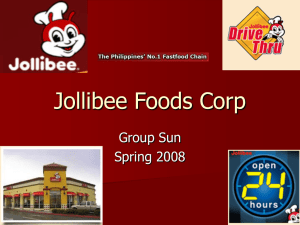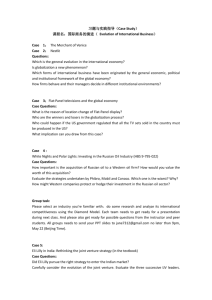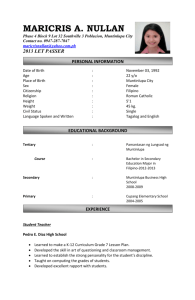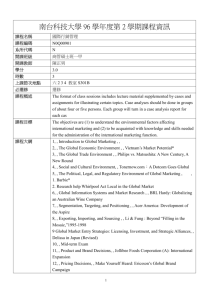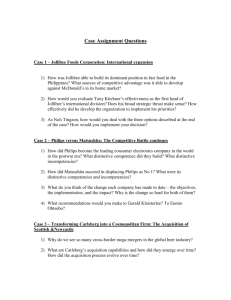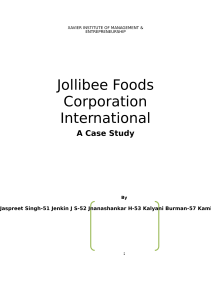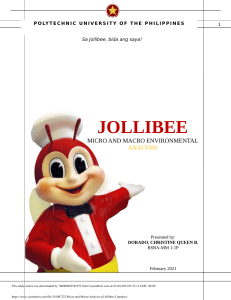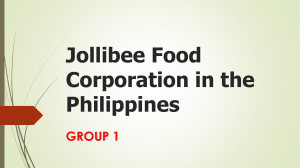The Fast Food Industry
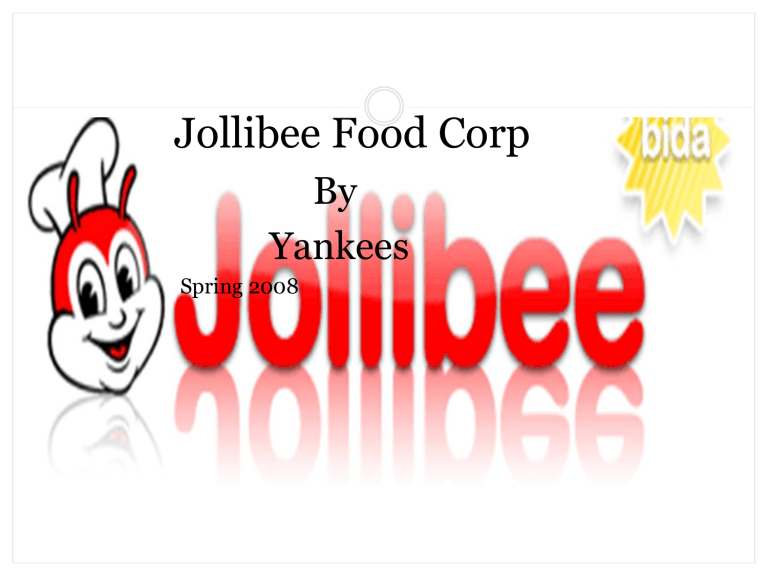
Jollibee Food Corp
By
Yankees
Spring 2008
Overview
History of Fast Food
History of Jollibee
Jollibee Vs. McDonalds
Jollibee International Division
Strategy: Three Decisions
The Fast Food Industry
Popularity begins: 1960’s
Pioneers
Ray Kroc - McDonalds
Colonel Sanders - Kentucky Fried Chicken
Concept
Serve time-constrained customers
Good quality food
Clean dining environment
Low pri ce
Profit Factors
●
High customer traffic
Convenience
Location
Speed o o o
Franchising (Fees and Royalties)
Chain-wide Consistence
Advertising and Purchasing economies of scale
Waste reduction
Jollibee Foods Corporation
Brief History
Founded by Chinese-Filipino Tan family in 1975 selling ice cream and sandwiches
Incorporated a 100% Filipino company 1978
First international venture - Singapore 1985
31 stores in 1986
All growth financed internally till 1993 IPO for
216 million Pesos ($8m)
Jollibee vs McDonalds - The Philippines Market
•
•
o o o
1981:
McDonalds enters the Philippines
Jollibee owns 11 restaurants
McDonalds builds 6 in two years o o
1983:
McDonalds - 27% market
Jollibee - 32%
2001:
McDonalds – 28%; 235 stores
Jollibee – 52%; >400 stores
Jollibee Wins Local Dominance
•
• o o o
Events in the general environment (Political)
– 1981 - 1986
Assassination
Public demonstration
Foreign investment slowdown o o
Operations management capability captured in “Five Fs” philosophy
Friendliness, Flavorful food, Fun atmosphere, Flexibility in catering to customer needs, Focus on families.
Close knit structure
Competitive Advantage
o
Business Level Strategy - Differentiation
Appeal to tastes and eating habits of locals – a distinctly
Filipino taste (Example: Champ
Vs
Big Mac)
• o
Company Perspective
Constant innovation and improvement in products, service and store design.
Corporate Strategy
Vertical Integration (Commissary)
Jollibee hotdog making line and meat processing line for burger patties
McDonalds - products are supplied to its commissary by different food firms
Cooperative (Franchising)
Royalties and Franchise Fees
Corporate Strategy
•
• o o o o o o o
Diversification
Jollibee
Greenwhich Pizza Corporation (Pizza-Pasta) - 1994
Delifrance (French Café - Bakery) - 1995
Chowking (Oriental Quick Service) – 2000
Yonghe King (Chinese Fast Food)
Red Ribbon (Cake and Pastries)
Chun Shui Tang (Tea Drinks)
Dominant Business Strategy 2001
Jollibee - 75%
Greenwhich Pizza - 11%
Chowking - 10 %
Others - 4%
International Ventures
Singapore – 1985
Misunderstanding with local partner; franchise revoked 1986
Taiwan
Conflict with partner
Property market; dissolved venture 1988
Brunei – 1987
Hands on involvement in operations
Good relationship with partner
Indonesia – 1989
Conflict with partner
Sold to new franchisee
Success Factors:
Partner relationship management
Prime Location
Tony Kitchner 1994 - 1997
Priority to develop International Division
Autonomy
Resources
Capabilities
Local partners with market connections
Image reinvention
Increase pace of international expansion
One of the world’s top 10 brands by 2000
Strategic Thrust
Targeting Expatriates
Pros: 1) Supports entry into market
2) Reduces need to customize menu
Cons:1) Limited market and growth
• Planting the Flag (First Mover Advantage)
Pros: 1) Establish Recognition
2) Secure resources
Con: 1) Rash market choices e.g Middle East
International Expansion
• o o
Opened 22 stores between 1994 and 1997
Asia – Planting the Flag
Middle East – Target Expats
• o
Evaluating Kitchner’s Strategy:
Kitchner’s strategy did make sense, and was effective in pursuing the goal of rapid expansion. However, his inability to work efficiently with the local division caused tension and the ultimate breakdown of the strategy.
Three Options
1.
Papua New Guinea:
Raising the standards.
2.
Hong Kong:
Expanding the base.
3.
California:
Supporting the settlers.
Decisions
Papua Guinea: Do not enter
Hong Kong: Expand
California: Enter
Conclusion
Jollibee is constantly growing around the world.
(2005-2006) o o o
System Wide Sales - 13.5%
Revenue – 16.8%
Foreign Business – 42.7%
Celebrating 30 years in Business

